Accounting Report: Stakeholders, Costing Systems Analysis
VerifiedAdded on 2020/06/06
|6
|1345
|66
Report
AI Summary
This accounting report provides a comprehensive overview of key accounting concepts. It begins by defining stakeholders within a conceptual framework, differentiating between internal and external stakeholders, and then discusses the construction of financial statements to meet stakeholder requirements, including balance sheets, income statements, and cash flow statements. The report then delves into the advantages and disadvantages of absorption and marginal costing methods, detailing their application in various business scenarios such as Kwik Fit garages, construction firms, and car manufacturing. The report concludes by emphasizing the importance of accounting in presenting a clear picture of a company's financial position and highlights the utility of different costing methods in the production of goods and services. References to relevant academic sources are also included.
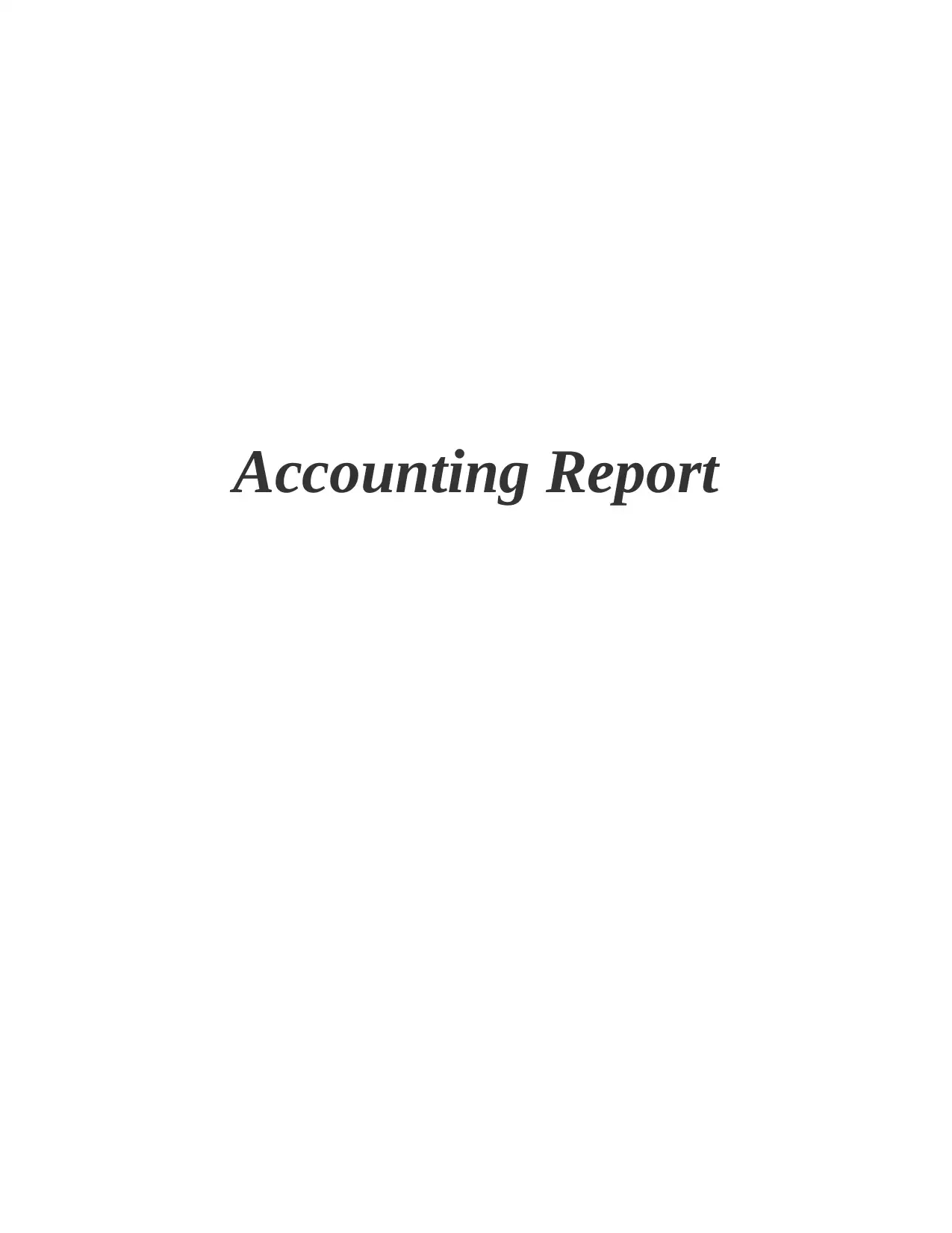
Accounting Report
Paraphrase This Document
Need a fresh take? Get an instant paraphrase of this document with our AI Paraphraser
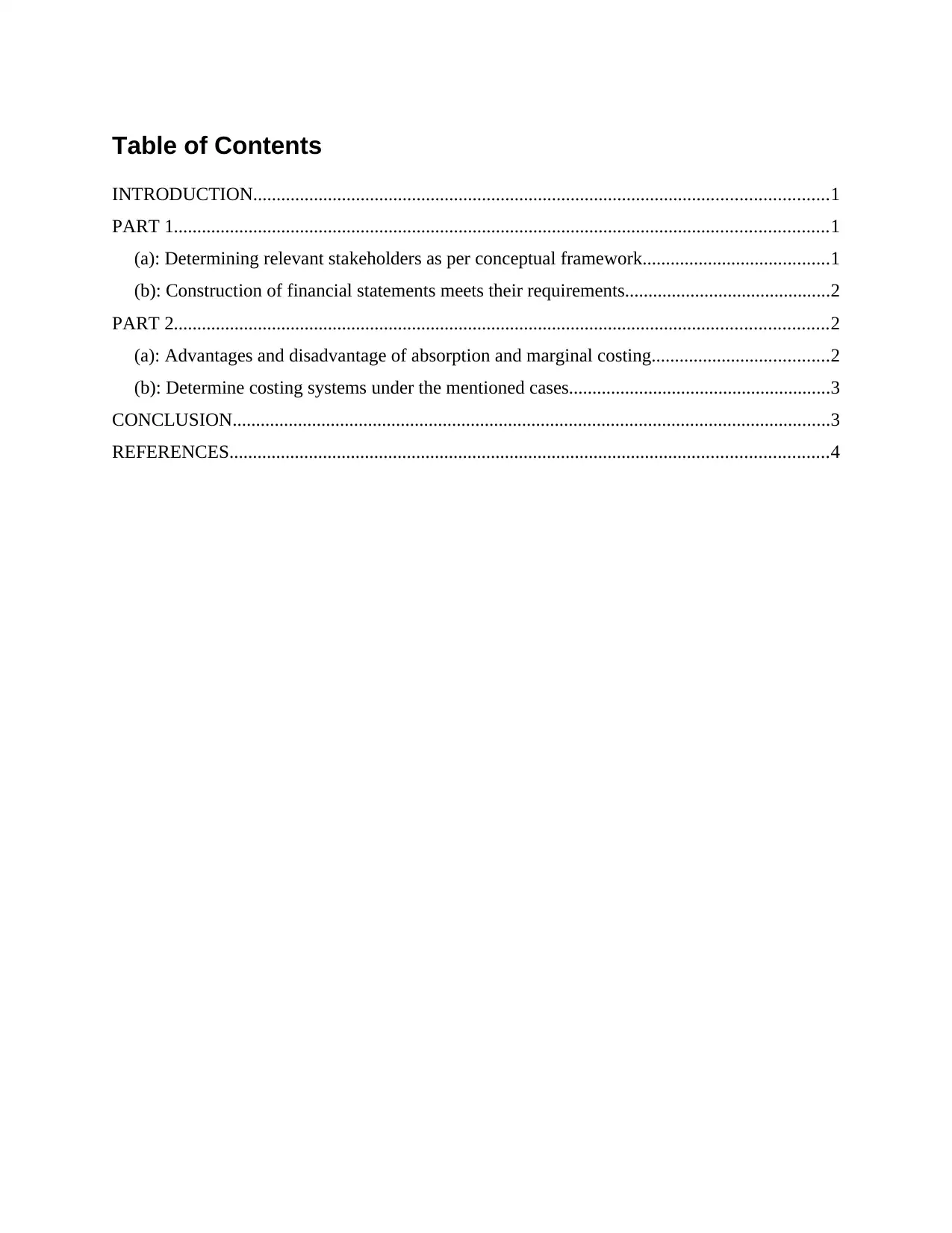
Table of Contents
INTRODUCTION...........................................................................................................................1
PART 1............................................................................................................................................1
(a): Determining relevant stakeholders as per conceptual framework........................................1
(b): Construction of financial statements meets their requirements............................................2
PART 2............................................................................................................................................2
(a): Advantages and disadvantage of absorption and marginal costing......................................2
(b): Determine costing systems under the mentioned cases........................................................3
CONCLUSION................................................................................................................................3
REFERENCES................................................................................................................................4
INTRODUCTION...........................................................................................................................1
PART 1............................................................................................................................................1
(a): Determining relevant stakeholders as per conceptual framework........................................1
(b): Construction of financial statements meets their requirements............................................2
PART 2............................................................................................................................................2
(a): Advantages and disadvantage of absorption and marginal costing......................................2
(b): Determine costing systems under the mentioned cases........................................................3
CONCLUSION................................................................................................................................3
REFERENCES................................................................................................................................4

INTRODUCTION
Accounting is one of the primary techniques by which organisation can record,
summaries, evaluated various financial transactions that are done by the company. There are
certain basis aspects that are useful in recording financial statements through taking into account
all standards and regulations. This project describe different types of stakeholders categories as
per the conceptual framework. Formulation of financial statements in accordances to meet their
basis required is done in proper manner (Gao, 2013). Merits and demerits of absorption and
marginal costing are also explain under this report.
PART 1
(a): Determining relevant stakeholders as per conceptual framework
Stakeholders are said to be one of the primary parts of any business. They are directly of
indirectly associated with decision making in future planning of any kind of activities that are
done by an organisation. As per the Conceptual framework which is assist the IASB in
formulating and revising IFRS that relies on consistent concepts to aid in regulate development
of accounting policies. There are various stakeholders those are operating for an organisation.
Some of them are:
Internal stakeholders: These are those parties who already responsible to serve an
organisation as board member, staff and investors.
Employees are working in the departments for the purpose of earning money and remain
employed in an organisation (Maskell, Baggaley and Grasso, 2011).
Owners responsible for making appropriate decision regarding upcoming plans in order
to increase profitability for an organisation.
Investors are responsive enough regarding income generating from their investments
made during the period of time.
External stakeholders: It refers as those individual that are committed to taken active
participation in an organisation from outside of an organisation. It consists of customers, partners
and other.
Customers wants business to provide upper quality of products and services at very
minimal costs.
Suppliers are held reliable for business to regulate business in order to purchase their
products on an continuous basis.
1
Accounting is one of the primary techniques by which organisation can record,
summaries, evaluated various financial transactions that are done by the company. There are
certain basis aspects that are useful in recording financial statements through taking into account
all standards and regulations. This project describe different types of stakeholders categories as
per the conceptual framework. Formulation of financial statements in accordances to meet their
basis required is done in proper manner (Gao, 2013). Merits and demerits of absorption and
marginal costing are also explain under this report.
PART 1
(a): Determining relevant stakeholders as per conceptual framework
Stakeholders are said to be one of the primary parts of any business. They are directly of
indirectly associated with decision making in future planning of any kind of activities that are
done by an organisation. As per the Conceptual framework which is assist the IASB in
formulating and revising IFRS that relies on consistent concepts to aid in regulate development
of accounting policies. There are various stakeholders those are operating for an organisation.
Some of them are:
Internal stakeholders: These are those parties who already responsible to serve an
organisation as board member, staff and investors.
Employees are working in the departments for the purpose of earning money and remain
employed in an organisation (Maskell, Baggaley and Grasso, 2011).
Owners responsible for making appropriate decision regarding upcoming plans in order
to increase profitability for an organisation.
Investors are responsive enough regarding income generating from their investments
made during the period of time.
External stakeholders: It refers as those individual that are committed to taken active
participation in an organisation from outside of an organisation. It consists of customers, partners
and other.
Customers wants business to provide upper quality of products and services at very
minimal costs.
Suppliers are held reliable for business to regulate business in order to purchase their
products on an continuous basis.
1
⊘ This is a preview!⊘
Do you want full access?
Subscribe today to unlock all pages.

Trusted by 1+ million students worldwide
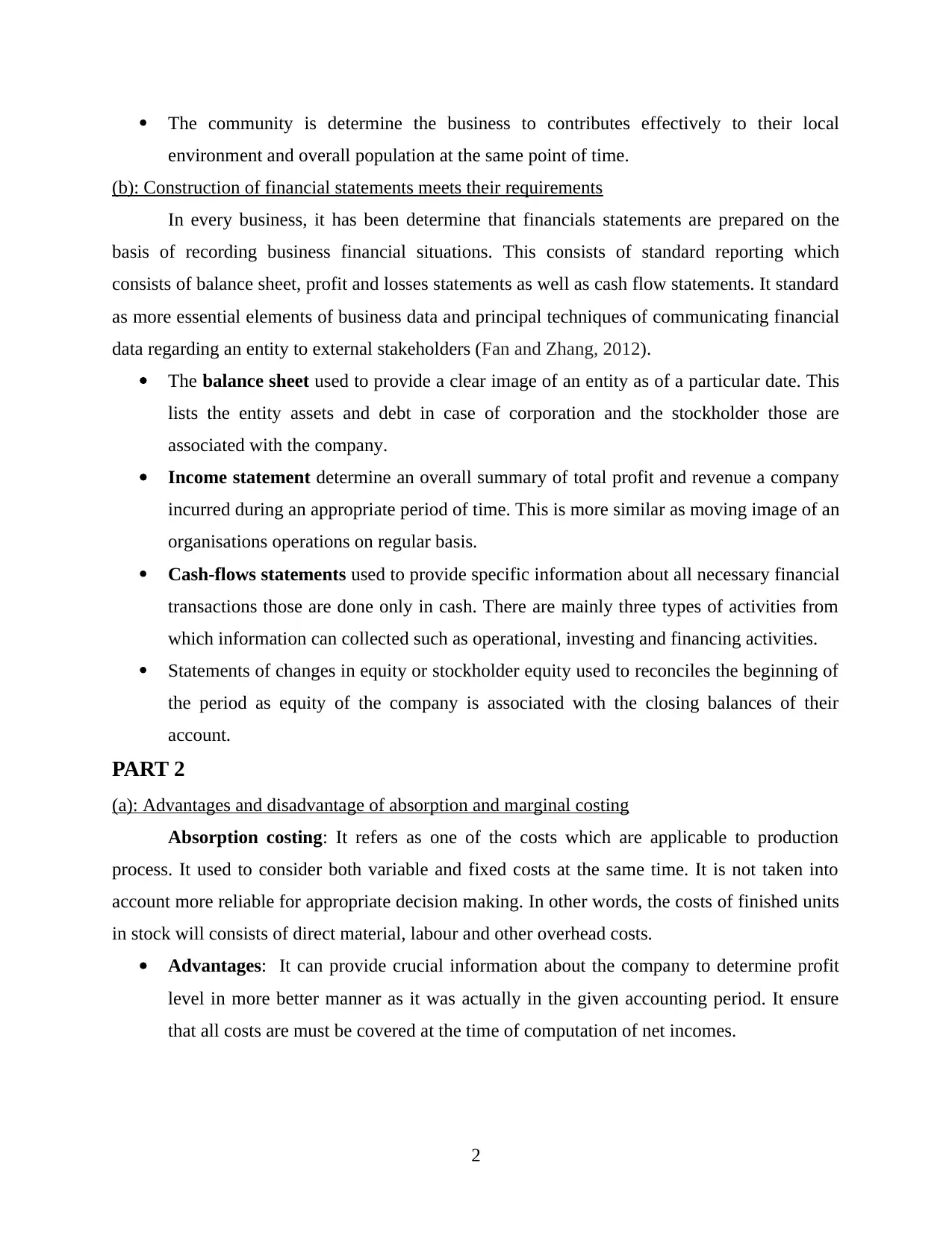
The community is determine the business to contributes effectively to their local
environment and overall population at the same point of time.
(b): Construction of financial statements meets their requirements
In every business, it has been determine that financials statements are prepared on the
basis of recording business financial situations. This consists of standard reporting which
consists of balance sheet, profit and losses statements as well as cash flow statements. It standard
as more essential elements of business data and principal techniques of communicating financial
data regarding an entity to external stakeholders (Fan and Zhang, 2012).
The balance sheet used to provide a clear image of an entity as of a particular date. This
lists the entity assets and debt in case of corporation and the stockholder those are
associated with the company.
Income statement determine an overall summary of total profit and revenue a company
incurred during an appropriate period of time. This is more similar as moving image of an
organisations operations on regular basis.
Cash-flows statements used to provide specific information about all necessary financial
transactions those are done only in cash. There are mainly three types of activities from
which information can collected such as operational, investing and financing activities.
Statements of changes in equity or stockholder equity used to reconciles the beginning of
the period as equity of the company is associated with the closing balances of their
account.
PART 2
(a): Advantages and disadvantage of absorption and marginal costing
Absorption costing: It refers as one of the costs which are applicable to production
process. It used to consider both variable and fixed costs at the same time. It is not taken into
account more reliable for appropriate decision making. In other words, the costs of finished units
in stock will consists of direct material, labour and other overhead costs.
Advantages: It can provide crucial information about the company to determine profit
level in more better manner as it was actually in the given accounting period. It ensure
that all costs are must be covered at the time of computation of net incomes.
2
environment and overall population at the same point of time.
(b): Construction of financial statements meets their requirements
In every business, it has been determine that financials statements are prepared on the
basis of recording business financial situations. This consists of standard reporting which
consists of balance sheet, profit and losses statements as well as cash flow statements. It standard
as more essential elements of business data and principal techniques of communicating financial
data regarding an entity to external stakeholders (Fan and Zhang, 2012).
The balance sheet used to provide a clear image of an entity as of a particular date. This
lists the entity assets and debt in case of corporation and the stockholder those are
associated with the company.
Income statement determine an overall summary of total profit and revenue a company
incurred during an appropriate period of time. This is more similar as moving image of an
organisations operations on regular basis.
Cash-flows statements used to provide specific information about all necessary financial
transactions those are done only in cash. There are mainly three types of activities from
which information can collected such as operational, investing and financing activities.
Statements of changes in equity or stockholder equity used to reconciles the beginning of
the period as equity of the company is associated with the closing balances of their
account.
PART 2
(a): Advantages and disadvantage of absorption and marginal costing
Absorption costing: It refers as one of the costs which are applicable to production
process. It used to consider both variable and fixed costs at the same time. It is not taken into
account more reliable for appropriate decision making. In other words, the costs of finished units
in stock will consists of direct material, labour and other overhead costs.
Advantages: It can provide crucial information about the company to determine profit
level in more better manner as it was actually in the given accounting period. It ensure
that all costs are must be covered at the time of computation of net incomes.
2
Paraphrase This Document
Need a fresh take? Get an instant paraphrase of this document with our AI Paraphraser
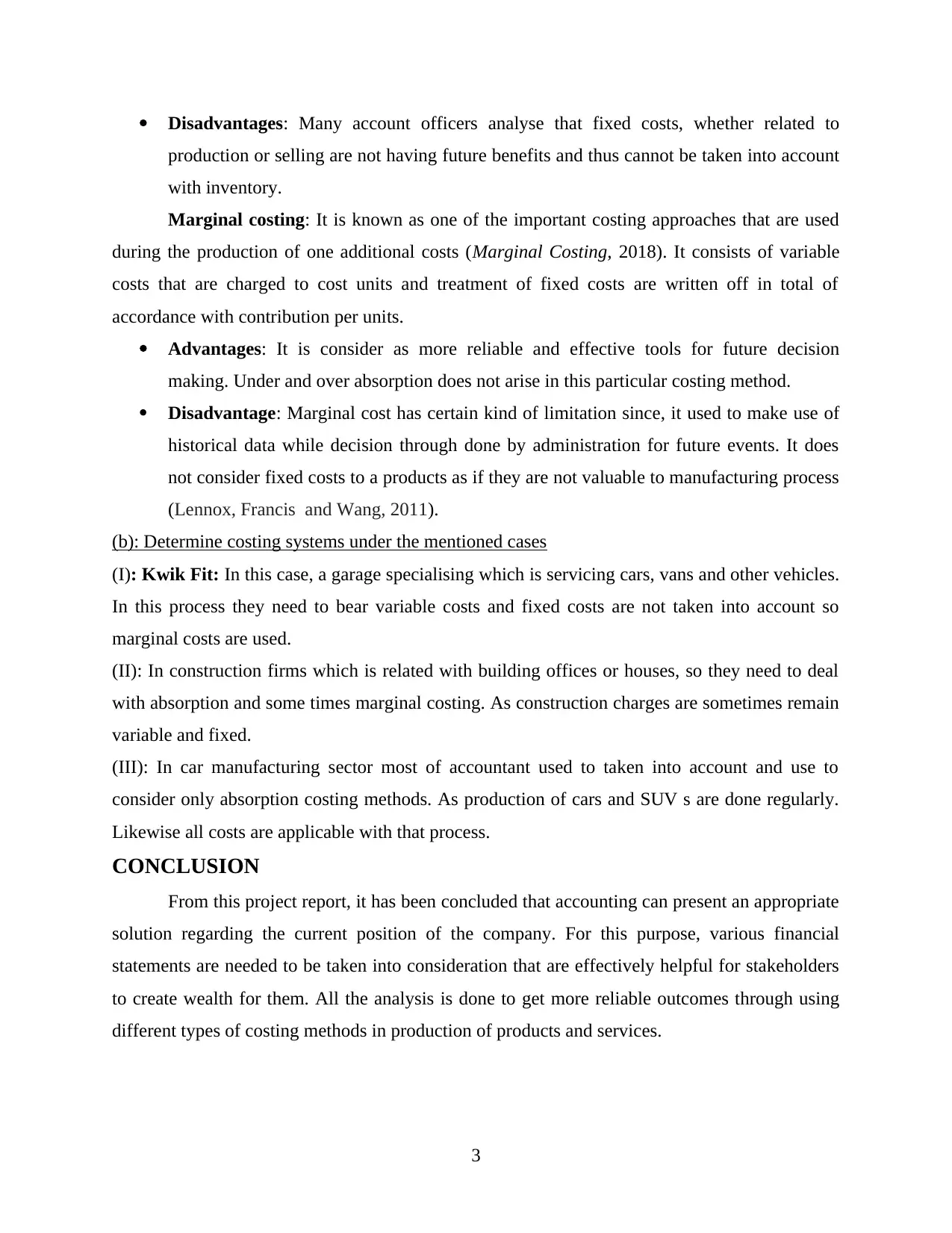
Disadvantages: Many account officers analyse that fixed costs, whether related to
production or selling are not having future benefits and thus cannot be taken into account
with inventory.
Marginal costing: It is known as one of the important costing approaches that are used
during the production of one additional costs (Marginal Costing, 2018). It consists of variable
costs that are charged to cost units and treatment of fixed costs are written off in total of
accordance with contribution per units.
Advantages: It is consider as more reliable and effective tools for future decision
making. Under and over absorption does not arise in this particular costing method.
Disadvantage: Marginal cost has certain kind of limitation since, it used to make use of
historical data while decision through done by administration for future events. It does
not consider fixed costs to a products as if they are not valuable to manufacturing process
(Lennox, Francis and Wang, 2011).
(b): Determine costing systems under the mentioned cases
(I): Kwik Fit: In this case, a garage specialising which is servicing cars, vans and other vehicles.
In this process they need to bear variable costs and fixed costs are not taken into account so
marginal costs are used.
(II): In construction firms which is related with building offices or houses, so they need to deal
with absorption and some times marginal costing. As construction charges are sometimes remain
variable and fixed.
(III): In car manufacturing sector most of accountant used to taken into account and use to
consider only absorption costing methods. As production of cars and SUV s are done regularly.
Likewise all costs are applicable with that process.
CONCLUSION
From this project report, it has been concluded that accounting can present an appropriate
solution regarding the current position of the company. For this purpose, various financial
statements are needed to be taken into consideration that are effectively helpful for stakeholders
to create wealth for them. All the analysis is done to get more reliable outcomes through using
different types of costing methods in production of products and services.
3
production or selling are not having future benefits and thus cannot be taken into account
with inventory.
Marginal costing: It is known as one of the important costing approaches that are used
during the production of one additional costs (Marginal Costing, 2018). It consists of variable
costs that are charged to cost units and treatment of fixed costs are written off in total of
accordance with contribution per units.
Advantages: It is consider as more reliable and effective tools for future decision
making. Under and over absorption does not arise in this particular costing method.
Disadvantage: Marginal cost has certain kind of limitation since, it used to make use of
historical data while decision through done by administration for future events. It does
not consider fixed costs to a products as if they are not valuable to manufacturing process
(Lennox, Francis and Wang, 2011).
(b): Determine costing systems under the mentioned cases
(I): Kwik Fit: In this case, a garage specialising which is servicing cars, vans and other vehicles.
In this process they need to bear variable costs and fixed costs are not taken into account so
marginal costs are used.
(II): In construction firms which is related with building offices or houses, so they need to deal
with absorption and some times marginal costing. As construction charges are sometimes remain
variable and fixed.
(III): In car manufacturing sector most of accountant used to taken into account and use to
consider only absorption costing methods. As production of cars and SUV s are done regularly.
Likewise all costs are applicable with that process.
CONCLUSION
From this project report, it has been concluded that accounting can present an appropriate
solution regarding the current position of the company. For this purpose, various financial
statements are needed to be taken into consideration that are effectively helpful for stakeholders
to create wealth for them. All the analysis is done to get more reliable outcomes through using
different types of costing methods in production of products and services.
3
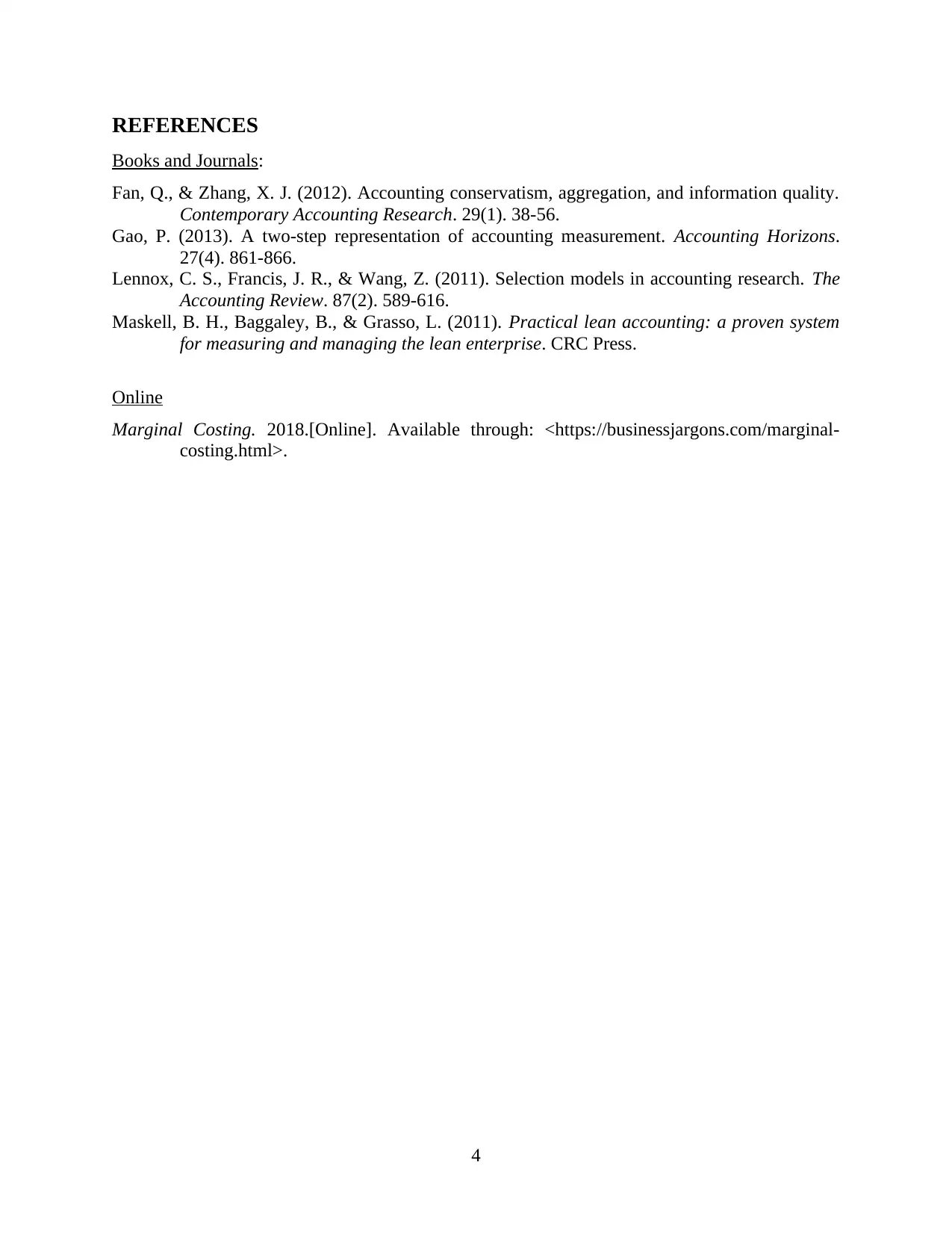
REFERENCES
Books and Journals:
Fan, Q., & Zhang, X. J. (2012). Accounting conservatism, aggregation, and information quality.
Contemporary Accounting Research. 29(1). 38-56.
Gao, P. (2013). A two-step representation of accounting measurement. Accounting Horizons.
27(4). 861-866.
Lennox, C. S., Francis, J. R., & Wang, Z. (2011). Selection models in accounting research. The
Accounting Review. 87(2). 589-616.
Maskell, B. H., Baggaley, B., & Grasso, L. (2011). Practical lean accounting: a proven system
for measuring and managing the lean enterprise. CRC Press.
Online
Marginal Costing. 2018.[Online]. Available through: <https://businessjargons.com/marginal-
costing.html>.
4
Books and Journals:
Fan, Q., & Zhang, X. J. (2012). Accounting conservatism, aggregation, and information quality.
Contemporary Accounting Research. 29(1). 38-56.
Gao, P. (2013). A two-step representation of accounting measurement. Accounting Horizons.
27(4). 861-866.
Lennox, C. S., Francis, J. R., & Wang, Z. (2011). Selection models in accounting research. The
Accounting Review. 87(2). 589-616.
Maskell, B. H., Baggaley, B., & Grasso, L. (2011). Practical lean accounting: a proven system
for measuring and managing the lean enterprise. CRC Press.
Online
Marginal Costing. 2018.[Online]. Available through: <https://businessjargons.com/marginal-
costing.html>.
4
⊘ This is a preview!⊘
Do you want full access?
Subscribe today to unlock all pages.

Trusted by 1+ million students worldwide
1 out of 6
Related Documents
Your All-in-One AI-Powered Toolkit for Academic Success.
+13062052269
info@desklib.com
Available 24*7 on WhatsApp / Email
![[object Object]](/_next/static/media/star-bottom.7253800d.svg)
Unlock your academic potential
Copyright © 2020–2025 A2Z Services. All Rights Reserved. Developed and managed by ZUCOL.





